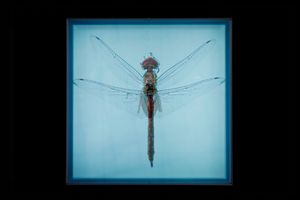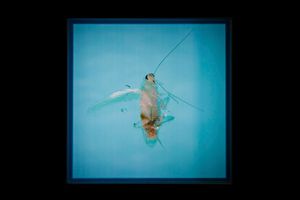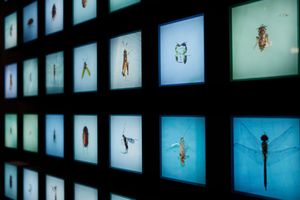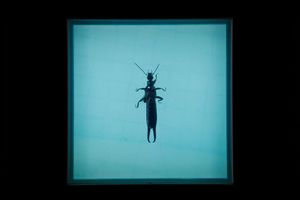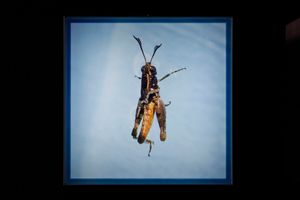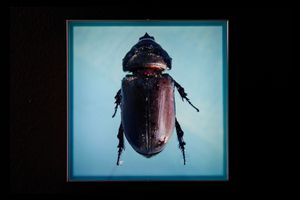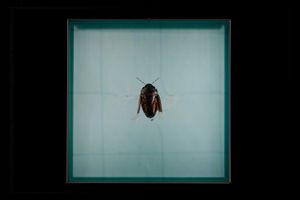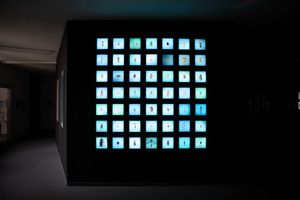Dead Insects In My Parents Pool
2013
Dead Insects in my Parents Pool_01_Installation Image_2012_Documentation_(c)Greven-9
Calculated Depth Of Field: Dead Insects In My Parents Pool (2013) - Fabian Lehmann
(translated from the German original)
I still get into pools, cool off, swim and dive. But I now have a feeling of guilty conscience. For me, the pool has lost its appeal of carefree enjoyment. It has been removed from the world of children and has become part of the enlightened world. Water is generally considered the source of life. And anyone who has ever spent a few hours at a pond in midsummer has an idea of what diving and floating in it is, and what whirrs and flickers around there. Now it is obvious that the pond and pool share nothing beyond the fact that they are holes filled with water.
A pool is sterile. At least that's the state he's aiming for. Not only are the blue-colored tiles easy to clean and quick to clean, and they are free of any growth that would suddenly appear in any other water hole. The water itself is, as far as possible, filtered and clean. In addition to using pumps and filters that constantly screen the water, this can only be achieved by adding chlorine. Chlorine turns the pool into a deadly trap for any winged animals that settle there. They poison themselves. The swimming pool enriched with chlorine becomes an expropriation of the water as a living space. As a pool basin, the water hole is no longer a biotope and the water is no longer a food, but a transparent liquid - sufficient as a mere aggregate state.
In the arrangement Dead Insects in My Parents Pool, Sam Hopkins presents the water desert in its life-threatening mercilessness. 49 square display cases illuminated from within are hung in such a way that they form a large square. Similar to a natural history collection, the identical aluminum boxes show photographs of insects, mostly taken individually, floating dead on the water in various positions. There are specimens from a wide variety of species that are placed in the center of the picture. Only in a few cases does a box show two individuals, which is due to their existing arrangement at the time of recording. Seeing the insects against a monochrome background creates an unusual and attractive image experience that highlights the delicate insects in high contrast. The focusing from a short distance, complemented by the shallow depth of field, reinforces this impression.
Hopkins' photographs shine in cool, unobtrusive colors. In the photo, the water solidifies and the insects, which used to buzz uncontrollably, are not only dead, but also photographically captured. This reveals details of the delicate little animals, which can be studied in detail in the light box. As a viewer, I look at death in its limitless arrogance - and am not frightened.
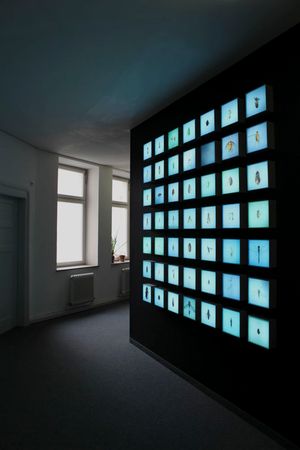
Dead Insects in my Parents Pool_01_Installation Image_2012_Documentation_(c)Greven-9
Even in the Natural History Museum, I don't get shocked when I look at skewered insects in a display case, isolated from their surroundings. I ignore individual life and death and understand each living creature on display as a representative of its own species. Since these are insects and not mammals, this distancing is achieved very directly and does not require learned affect control. I don't see anything here that could remind me of my own existence, my own mortality. My reaction is rather an astonished pause at the ingenuity of evolution. Dead Insects in My Parents Pool is both a requiem and a celebration of life.
The hanging of the aluminum boxes in Hopkins' arrangement is aesthetically balanced and creates a balance between geometric rigor and the individual characteristics of the documented animals. The tone of the water varies between pale turquoise and deep blue. How is such a variety of colors possible under the controlled and actually static conditions of a swimming pool? This cannot be explained by different camera exposure times alone. Rather by the depth of the pool, the weather conditions at the time the photo was taken and the angle and intensity of the incident light.
In this work, Hopkins is a stroller who repeatedly walks along the edge of the pool over several years. He doesn't need to stage anything, just observe and document. He writes himself into the work. According to the title of the work, it is always the same pool on his parents' property. This means that the swimming pool is removed from anonymity and is placed into a social structure that provokes further questions. For example, according to the origin of the parents and the economic and social status of the family. Inevitably I am tempted to imagine what property the pool is on, what neighborhood the property is part of. A pool is undeniably a luxury facility, its installation and maintenance requiring spatial and financial requirements. In temperate Central Europe it evokes associations with summer holidays and Mediterranean, perhaps subtropical latitudes.
The work is directly linked to my memories and initially only awakens pleasant associations. Only the pause, provoked by the wealth of detail, the approach to the individual boxes and the understanding of the dead animals as such, creates a break with what I remember and brings me back to the now. I then think about the fact that swimming pools are particularly popular in areas where water is scarce and that is precisely why they are luxurious. That they arise from a petty-bourgeois need to participate in the achievements of the market economy and are terribly boring in their uniformity and coldness.
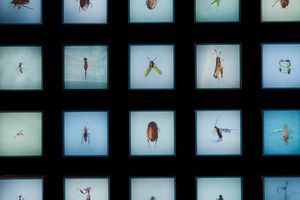
Dead Insects in my Parents Pool_01_Installation Image_2012_Documentation_(c)Greven-14
If I could remain on the surface, I would only have to notice the beauty of the arrangement, the play of colors and the interesting objects. But Dead Insects in My Parents Pool is not a pleasant work. It only makes use of the lightness to capture me as a viewer and, shortly after, to make me stumble so that I can sink in and explore the depth of its sharpness
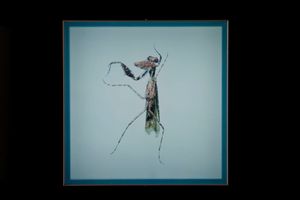
Dead Insects in my Parents Pool_01_Installation Image_2012_Documentation_(c)Greven-11
download text as PDF